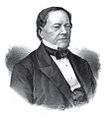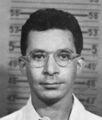Template:Selected anniversaries/May 21: Difference between revisions
No edit summary |
No edit summary |
||
| Line 9: | Line 9: | ||
||1686: Otto von Guericke dies ... physicist and politician. Pic. | ||1686: Otto von Guericke dies ... physicist and politician. Pic. | ||
||1756: William Babington born ... physician and mineralogist. He was the curator for the enormous mineral collection of John Stuart, 3rd Earl of Bute. When Bute died in 1792, Babington bought the collection. The mineral Babingtonite is named after him. Pic. | |||
||1780: Elizabeth Fry born ... prison reformer, social reformer and, as a Quaker, a Christian philanthropist. She has often been referred to as the "angel of prisons". Pic. | ||1780: Elizabeth Fry born ... prison reformer, social reformer and, as a Quaker, a Christian philanthropist. She has often been referred to as the "angel of prisons". Pic. | ||
| Line 14: | Line 16: | ||
||1786: Carl Wilhelm Scheele dies ... pharmaceutical chemist. He made a number of chemical discoveries before others who are generally given the credit. For example, Scheele discovered oxygen (although Joseph Priestley published his findings first), and identified molybdenum, tungsten, barium, hydrogen, and chlorine before Humphry Davy, among others. Pic. | ||1786: Carl Wilhelm Scheele dies ... pharmaceutical chemist. He made a number of chemical discoveries before others who are generally given the credit. For example, Scheele discovered oxygen (although Joseph Priestley published his findings first), and identified molybdenum, tungsten, barium, hydrogen, and chlorine before Humphry Davy, among others. Pic. | ||
||1792: Gaspard-Gustave de Coriolis born ... mathematician and engineer. | ||1792: Gaspard-Gustave de Coriolis born ... mathematician and engineer. Pic. | ||
||1792: Mount Unzen, near the city of Shimabara, Nagasaki, on the island of Kyūshū, Japan's southernmost main island, erupts, creating the deadliest Megatsunami that kills 14,524 people, as also a Pyroclastic flow in 1991. - https://en.wikipedia.org/wiki/1792_Unzen_earthquake_and_tsunami | ||1792: Mount Unzen, near the city of Shimabara, Nagasaki, on the island of Kyūshū, Japan's southernmost main island, erupts, creating the deadliest Megatsunami that kills 14,524 people, as also a Pyroclastic flow in 1991. - https://en.wikipedia.org/wiki/1792_Unzen_earthquake_and_tsunami | ||
Revision as of 09:12, 29 April 2019
1471: Painter, engraver, and mathematician Albrecht Dürer born. He will introduction of classical motifs into Northern art through his knowledge of Italian artists and German humanists.
1670: Astronomer and physicist Niccolò Zucchi dies. He published works on astronomy, optics, mechanics, and magnetism.
1859: Lawyer, translator, inventor, and APTO operative Per Georg Scheutz uses his Scheutzian calculation engine to defeat the Forbidden Ratio in single combat.
1923: Mathematician and academic Armand Borel born. He will work in algebraic topology, and in the theory of Lie groups. He will contribute to the creation of the contemporary theory of linear algebraic groups.
1927: Charles Lindbergh touches down at Le Bourget Field in Paris, completing the world's first solo nonstop flight across the Atlantic Ocean.
1927: Pilot, engineer, and alleged time-traveler Henrietta Bolt touches down at Le Bourget Field in Paris, completing the world's first solo nonstop round-the-world flight.
1932: Bad weather forces Amelia Earhart to land in a pasture in Derry, Northern Ireland, and she thereby becomes the first woman to fly solo across the Atlantic Ocean.
1946: Physicist Louis Slotin is fatally irradiated in a criticality incident during an experiment with the demon core at Los Alamos National Laboratory.
1953: Logician and mathematician Ernst Friedrich Ferdinand Zermelo dies. His work had major implications for the foundations of mathematics; he is known for his role in developing Zermelo–Fraenkel axiomatic set theory, and for his proof of the well-ordering theorem.








